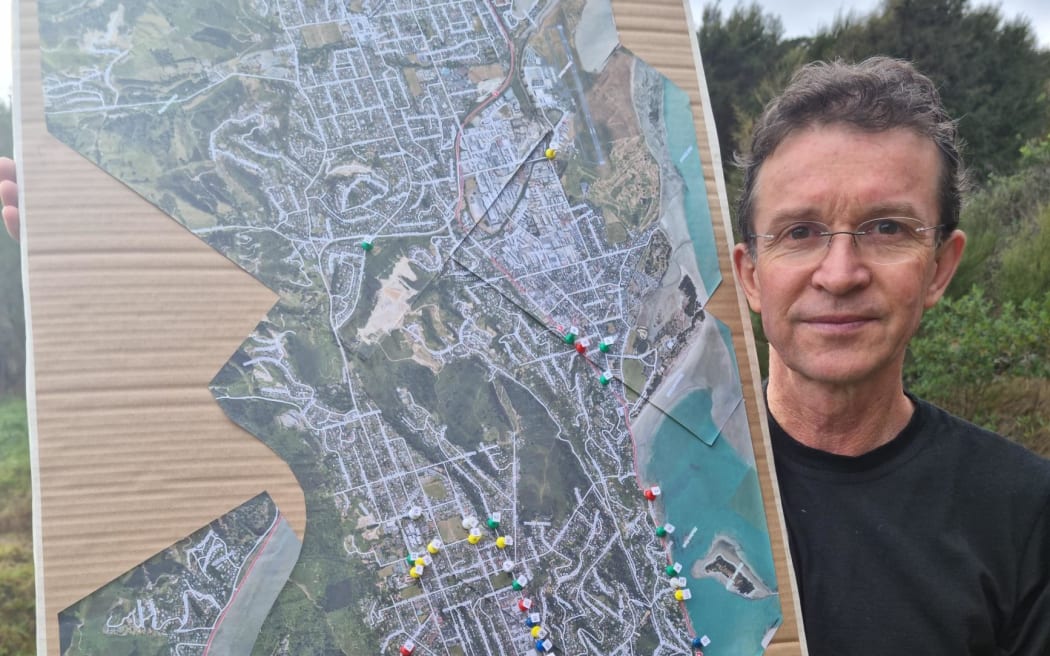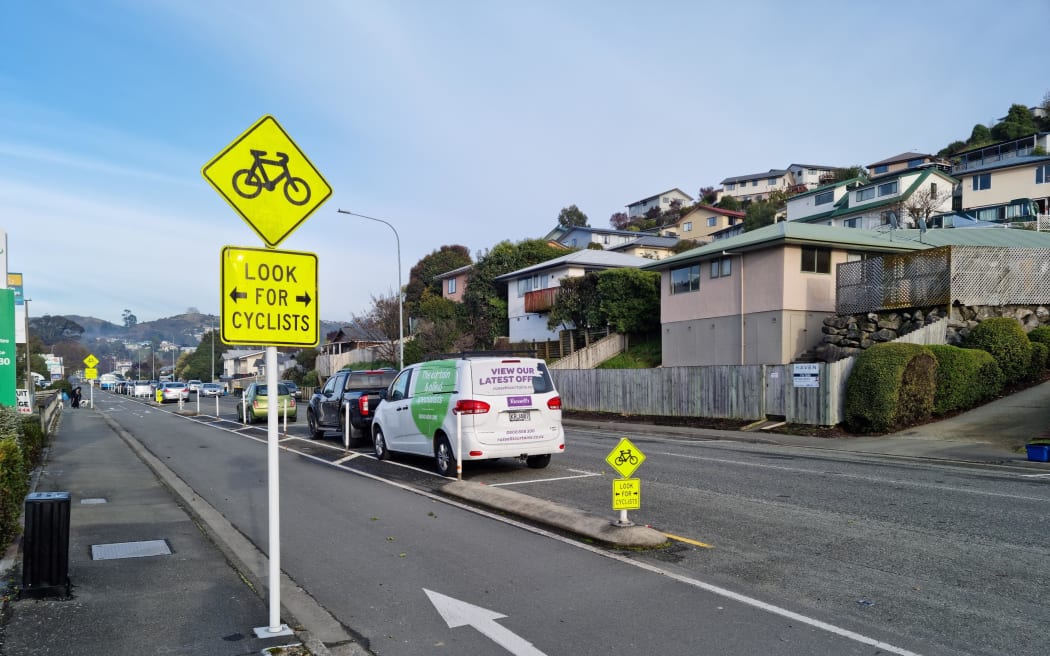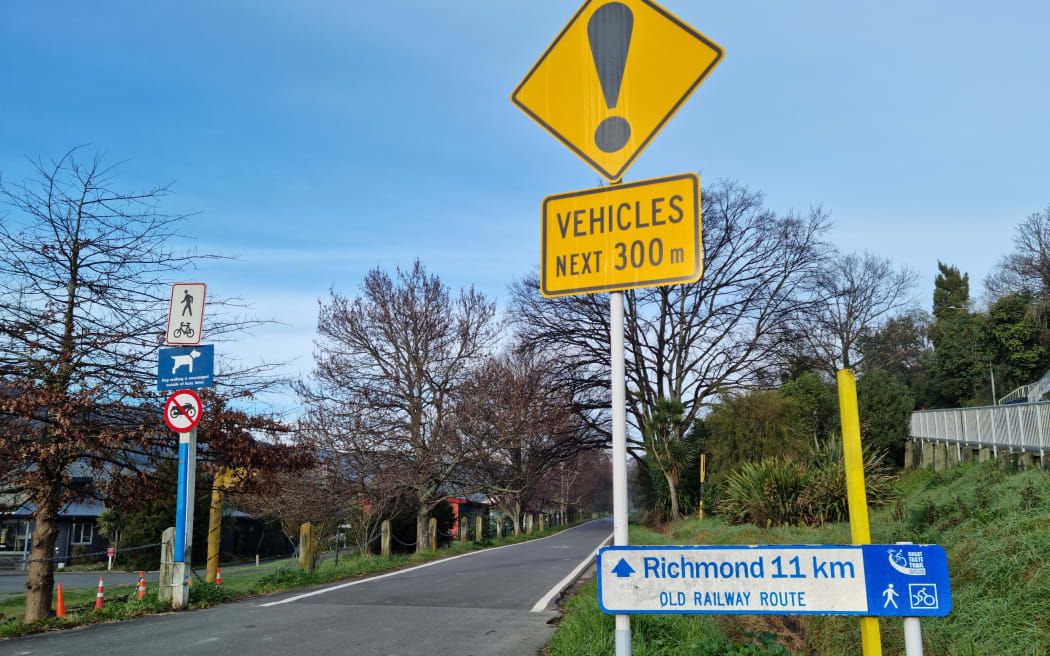Nelson has the highest number of people cycling to work in New Zealand but sustainable transport advocates say ditching the car still is not a safe enough option for many.

Nelsust convener Peter Olorenshaw with a map of Nelson depicting hazardous spots for walkers and cyclists. Photo: RNZ / Samantha Gee
The Nelson City Council is asking residents what they think of plans to reduce private vehicle use and increase active modes of transport outlined in its active travel strategy - E Tū Whakatū.
Nelsust, a group that campaigns for sustainable transport, has gathered information from walkers and cyclists about the hazards they face.
Convener Peter Olorenshaw said it was a chance to "stress test" what the council was proposing.
"We had this opportunity for people to put a numbered pin in on a map of Nelson where they had issues for safety when they were biking or walking - that was the point of the travel justice rally, that it's not just for people to fear being maimed, when they go out on the streets in anything other than a car."
There are 82 pins on the map that identify areas where people have had accidents, near misses or feel unsafe when travelling through the city on foot or by bike.
Olorenshaw said the council's draft active travel strategy had laudable goals but no comprehensive plan to actually improve safety.
The council wanted to see the distance vehicles travel reduced by 25 percent and the proportion of people walking and cycling to work and school doubled by 2035 - along with no deaths or serious injuries on the network by then.

The separated cycleway on St Vincent St in Nelson. Photo: RNZ / Samantha Gee
Figures from Stats NZ show Nelson city has the highest proportion of people cycling to work in the country at 6.1 percent, above the national figure of 2 percent.
Olorenshaw said people could do "far better" than that.
"It's not about forcing people out of cars, it's about giving people better options so what we say is that we want to make walking and cycling the most attractive option for most people, most of the time."
In the Netherlands, about 27 percent of people use bicycles for their home-work commute, with that figure rising to 55 percent for those who live within five kilometres of their workplace.
Olorenshaw said the recently adopted walking and cycling strategy in the neighbouring Tasman District was gold standard.
It will see a blanket 30 kilometre-per-hour speed zone across all urban areas, except for streets that have separate cycleways.
Nelsust wanted to see those same changes made in Nelson.
"It's the magic thing at 30 kilometres per hour, it's safe to mix cycling and motor vehicles," Olorenshaw said.
"Without the need to put cycle lanes on every street you suddenly have a huge network of safe cycling areas with existing streets, mixing the cars and the cyclists just through that speed reduction."

The Railway Reserve cycleway links Nelson with Richmond. Photo: RNZ / Samantha Gee
Tasman District Council transport planner Clare Scott said there was a strong desire from the community to make the transport network more friendly for walkers and cyclists.
Its Walking and Cycling Strategy 2022-52, adopted in May, was driven by a need to reduce domestic CO2 emissions alongside creating safer, more liveable and accessible neighbourhoods.
It aimed to double the number of trips to work and school made by walking or cycling by 2030, and triple them by 2050.
"The backbone of the strategy is really creating a safe, connected and continuous cycle network, what we've got now and what you often see around in urban areas is bits of cycleways that end in a parked car, or are okay for 100 metres and then disappear and we know that's not good enough anymore."
That meant designing a network easily navigated by 8-year-olds and 80-year-olds.
"It's not rebuilding the network but using what we already have better, reallocating that road space away from being available for car parking, to creating safe separated cycleways so that people can get safely from one place to another for the whole journey."
University of Otago professor Michael Keall studied walking and cycling by people in Hastings and New Plymouth, after both cities received funding from Waka Kotahi in 2011 through the Model Communities Programme to encourage active travel.
"Generally, the research shows that the best way to get new people cycling and walking is to address one of the major barriers, which is safety. This applies particularly to women who want to cycle and also children. Providing infrastructure that is separated is very important."
Nelson City Council infrastructure chair Brian McGurk said the council was well aware of the dangers faced by walkers and cyclists in the region.
"We've had lots of feedback about various choke points in places around the network that people just don't feel safe - and they aren't safe.
"Roundabouts are a classic example, the speed of vehicles on roads, places where the network is disconnected.
"One of the parts of the strategy is prioritising that kind of work so people have a safe, connected active transport network."
He said it was important there was consistency across both Nelson and Tasman when it came to active travel.
"What what you see in the Tasman strategy, you'll see in the Nelson strategy, the two are very much aligned, we've worked very closely with our colleagues across the boundary."
McGurk said it seemed like a daunting challenge but it was one the council was ready for.
"Nelson is a city that more recently has been designed around cars as our primary means of transport and we're proposing a substantial investment in things like improved footpaths and cycleways that will make walking and cycling more enjoyable, safer and healthier."
Nelson City Council is asking the community what it thinks of the targets in the E Tū Whakatū strategy and if it supports the removal of parking spaces to create safer walking and cycling facilities.
Feedback can be given on the draft strategy until 25 July.


